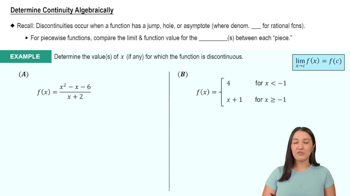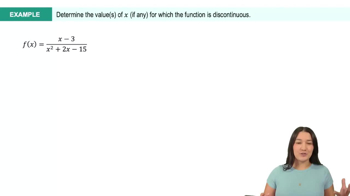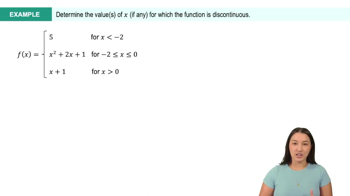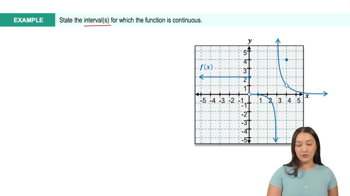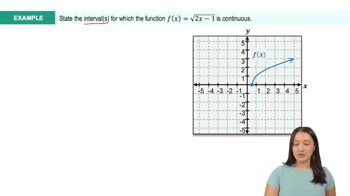Table of contents
- 0. Functions7h 52m
- Introduction to Functions16m
- Piecewise Functions10m
- Properties of Functions9m
- Common Functions1h 8m
- Transformations5m
- Combining Functions27m
- Exponent rules32m
- Exponential Functions28m
- Logarithmic Functions24m
- Properties of Logarithms34m
- Exponential & Logarithmic Equations35m
- Introduction to Trigonometric Functions38m
- Graphs of Trigonometric Functions44m
- Trigonometric Identities47m
- Inverse Trigonometric Functions48m
- 1. Limits and Continuity2h 2m
- 2. Intro to Derivatives1h 33m
- 3. Techniques of Differentiation3h 18m
- 4. Applications of Derivatives2h 38m
- 5. Graphical Applications of Derivatives6h 2m
- 6. Derivatives of Inverse, Exponential, & Logarithmic Functions2h 37m
- 7. Antiderivatives & Indefinite Integrals1h 26m
1. Limits and Continuity
Continuity
Problem 2.48
Textbook Question
Determine the interval(s) on which the following functions are continuous. At which finite endpoints of the intervals of continuity is f continuous from the left or continuous from the right?
f(z)=(z−1)^3/4
 Verified step by step guidance
Verified step by step guidance1
<Step 1: Identify the type of function.> The function \( f(z) = (z-1)^{3/4} \) is a power function with a fractional exponent. Fractional exponents can introduce discontinuities, especially when the base is negative.
<Step 2: Determine the domain of the base.> The base of the power function is \( z-1 \). For the expression \( (z-1)^{3/4} \) to be real-valued, \( z-1 \) must be non-negative because the fourth root of a negative number is not real. Therefore, \( z-1 \geq 0 \), which implies \( z \geq 1 \).
<Step 3: Establish the interval of continuity.> Based on the domain restriction, the function is defined and continuous for \( z \geq 1 \). Thus, the interval of continuity is \([1, \infty)\).
<Step 4: Analyze continuity at the endpoint.> At \( z = 1 \), the function \( f(z) = (z-1)^{3/4} \) evaluates to zero, which is defined. Since the function is defined and continuous for all \( z \geq 1 \), it is continuous from the right at \( z = 1 \).
<Step 5: Conclude the analysis.> The function is continuous on the interval \([1, \infty)\) and continuous from the right at the endpoint \( z = 1 \).
Recommended similar problem, with video answer:
 Verified Solution
Verified SolutionThis video solution was recommended by our tutors as helpful for the problem above
Video duration:
3mPlay a video:
Was this helpful?
Key Concepts
Here are the essential concepts you must grasp in order to answer the question correctly.
Continuity of Functions
A function is continuous at a point if the limit of the function as it approaches that point equals the function's value at that point. For a function to be continuous over an interval, it must be continuous at every point within that interval. This concept is crucial for determining where the function does not have breaks, jumps, or asymptotes.
Recommended video:

Intro to Continuity
Endpoints of Intervals
Endpoints of intervals are the boundary points that define the start and end of an interval. When analyzing continuity, it is important to check the behavior of the function at these endpoints, particularly whether the function approaches a finite limit from the left or right. This helps in identifying if the function is continuous from one side at these points.
Recommended video:
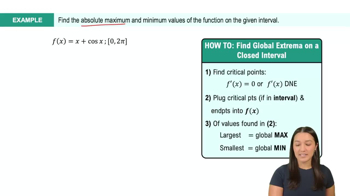
Finding Global Extrema (Extreme Value Theorem) Example 4
Piecewise Functions and Roots
The function given, f(z) = (z - 1)^(3/4), involves a root which can affect continuity. Specifically, roots can introduce points where the function is not defined or is discontinuous. Understanding how to handle roots, especially when they are raised to fractional powers, is essential for determining the intervals of continuity and the nature of the function at those points.
Recommended video:
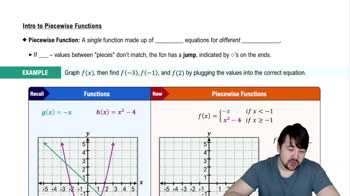
Piecewise Functions
Related Videos
Related Practice




